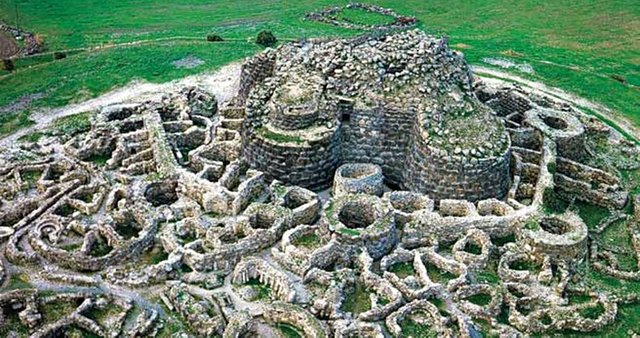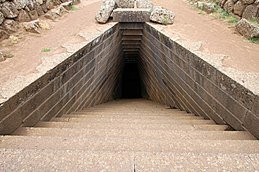Faci de su 1.600 ananti de Gesugristu, cumentzat a si formai in Sardìnnia sa curtura chi oi ddi naraus nuràgica, de su monumentu principali de custa curtura.
Around 1600 B.C., a culture starts developing in Sardinia and it is named after its most characteristic architectural feature, the "Nuraghe/Nuraxi". We're talking about the Nuragic civilization.

Su nuràgicu arcàicu si manifestat cun is proto-nuraxis, costrutzionis megalìticas de forma irregulari, cun aposentus a tholos e passaditzus.
The archaic nuragic culture was characterized by the "Proto-nuraxis", irregular buildings made out of megaliths that had both rooms and tight corridors.

Faci de su 1.200 a.C. est su Tempus de is nuraxis cràssigus. Sa turri nuràgica lòmpit insaras a sa perfetzioni formali. Una turri podiàt arribai a prus de 20 metrus de artària e tenni a intrus tres aposentus a tholos unu a pitzus de s’àteru, e una spirali de scalas intras de is murus.
Around 1.200 B.C, Nuragic architecture developes the "Classic Nuraghes" buildings. The Nuragic tower got the shape that can still be seen today. A tower could reach 20 meters of height and it could have up to three floors, where each one would correspond to a room and they were connected by a snail stairway built through the walls.

A pustis de custu perìodu s’assistit a sa ammanniadura de is nuraxis prus impostantis cun bastionis e turris formendi is nuraxis polilobaus, aundi a giru si formant biddas de barracas, cumenti in Barùmini o a su nuràxi Orrùbiu de Orroli.
From this period on, the already existing Nuraghes, especially the most strategic and important ones, were extended and encircled by bastions and perimeters' towers around which huts were build. Such examples can be seen in Barùmini complex or in the Nuraghe Orrùbiu in Orroli.

Unu monumentu importanti meda de custu tempus, chi est acapiau a su curtu de is mortus, est sa tumba de is gigantis, chi fiat una tumba còmuna chi bia de in artu, teniat sa forma de una conca de boi. A s’inghìtzu is tumbas fiant fatas cun sa tènnica dolmènica, cun-d’una losa manna in s’afaciada, a pustis, s’impèrat sa tènniga a filaris de perdas, paris a sa tènniga de is turris nuràgigas.
Another important monument of that age, that is connected to the cult of the deads, is the Tomb of the Giants, a mass grave tha, seen from above. it's got the shape of a bull's head. At first, these tombs were done with a Dolmen technique, placing a huge stone on the main facade. Later on, the "stones in row" technique was used, together with the technique employed to build the Nuragic towers.

A su curtu de s’àcua invècias est acapiau un àteru monumentu stravanau tìpigu de s’edadi nuràgiga, chi est su tempru a putzu. Fiat unu tempru a suta de terra fatu de un’aposentu a Tholos chi in pomentu s’oberia sa mitza de àcua, e in cust’aposentu s’arribàt de una scala a forma de triàngulu, lada a pitzus e strinta in bàsciu.
Furthermore, there is another very interesting Nuragic monument linked to the cult of water that is called the temple-water well. It was a Temple built below earth where the water source would come out through the pavement and you get to the bottom of the temple through a triangle-shaped stairway, wide on the upper side and narrow on the bottom side.

S’edadi de su ferru est su tempus de sa decadèntzia. A primu is annus scurius intras de su 1100 e su 1000 ananti de Gesucristu, e a pustis is primus aposentamentus fenìcius e a pustis pùnicus ponint in crisi sa strutura socio-curturali de sa civiltadi nuràgica. A custu Tempus perou torrat sa statuària nuràgiga, sia sa de is brunzitus, chi sa megalitìgas cumenti is stàtuas de Monti Prama. Custas stàtuas contant stòrias de unu tempus atesu de dus ou tres sègulus prima, de eròis, capus, predis e feminas matriarcas.
The Iron Age is the age of decay for the Nuragic civilization seeing it went through the dark and difficult century between 1100 and 1000 B.C. first and, later, the Nuragic socio-cultural structural come into crisis once the first Phoenicians and Punic settlements are established on the island. However, to this difficult time we cand date the Nuragic sculpture technique represented by the Brunzitus statues and by the bigger Monte Prama statues. These statues tell about a far away age that dates back to two or three centuries before and they represent Heads of Tribe, Warriors, Shamans and matriarcal women. Thanks a lot for reading this summary about the Sardinian Nuragic architecture. If you're interested about Sardinian language and history, I would be honoured to guide you to this fascinating spoken and cultural heritage.

A si biri! See you soon!
